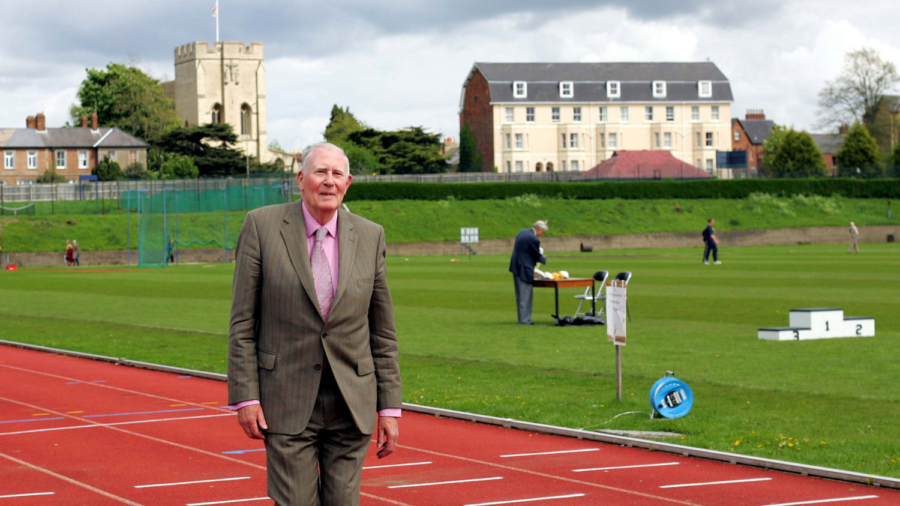LONDON—Roger Bannister, who has died aged 88, will live forever in the annals of athletics history as the first man to run a mile in under four minutes.
A statement from his family on Sunday said: “Sir Roger Bannister, died peacefully in Oxford on 3 March, aged 88, surrounded by his family who were as loved by him, as he was loved by them.
“He banked his treasure in the hearts of his friends.”
British Prime Minister Theresa May led the tributes to the former athlete, who later became one of Europe’s leading neurologists and was made a knight.
“Sir Roger Bannister was a great British sporting icon whose achievements were an inspiration to us all. He will be greatly missed,” she said on Twitter.
The “miracle mile” was run on the Oxford University track during a local athletics meeting with only a few spectators witnessing the Englishman’s destruction of the myth that no human being could run so fast.
Bannister made headlines around the world at the age of 25. His achievement opened the physical and psychological door for many other milers who have since beaten his time of three minutes 59.4 seconds.
Roger Gilbert Bannister, born in Harrow, a London suburb, on March 23, 1929, was a shy, gangling medical student who preferred to be an oarsman rather than a runner.
In 1946, when he went to Oxford, his great ambition was to row against Cambridge in the annual boat race on the Thames.
But Bannister, who stood 1.8 meters tall and weighed only 68 kilograms, was told he was too light to make a first-rate oarsman.
So he turned to running and his new ambition became to win the 1,500 meters at the Olympic Games in Helsinki in 1952.
Bannister started a five-year build-up and in 1947 at the age of 17 at Oxford ran his first mile race, finishing second in a time of just over five minutes. Later that year he won the mile for Oxford against Cambridge in an athletics meeting.
Lone Wolf
He asked for his name to be withdrawn from a list of 1948 Olympic possibles and continued his careful preparations for the 1952 games. But he managed only fourth place in the Helsinki Games 1,500 meters final.

The press criticized him for faulty training methods. Bannister, nicknamed the “lone wolf miler” because he scorned coaches, had worked out his own training schedule to fit in with his studies.
After Helsinki he became the forgotten man of athletics. But he had set his sights on the four-minute-mile — a challenge which had fascinated athletes and enthusiasts for years.
The world record was gradually being whittled down and a number of athletes were considered capable of crashing the four-minute barrier.
Australia’s great miler, John Landy, recorded a four minutes 2.1 seconds mile in December 1952 and Bannister cut this to four minutes two seconds in June 1953.
With American Wes Santee trying to lower his U.S. record of four minutes 2.4 seconds, the pressure was on and four-minute-mile fever was mounting. To Bannister, the challenge was not only to break the barrier but to be the first man to do so.
The Oxford University versus Amateur Athletics Association fixture of May 6 was the first competition of the British season of 1954. Bannister, by then a medical student at a London hospital, set that day for his attempt.
He enlisted the aid of his training companions and friends Chris Chataway and Chris Brasher, top athletes in their own right, as pacemakers.
May 6 was cold, wet and windy – not ideal for a record-breaking attempt. Bannister thought of calling it off but after a short rain shower and with a drop in the wind, he said: “Right, I’ll try.”
Medical Career
After a false start by pacemaker Brasher, the field of six got away. Bannister urged Brasher to go faster and at the halfway mark called on Chataway to take over from the tiring Brasher.
Then 210 meters from the tape he pulled out from behind Chataway to immortalize himself as the first sub-four-minute miler.
Seven weeks later Landy beat Bannister’s record with a mile in three minutes 57.9 seconds and in August, Bannister lowered his own time to three minutes 58.8 seconds, beating Landy at the Commonwealth Games in Vancouver, Canada.
In August 1954, Bannister captured the European 1500 meters crown. Having qualified as a doctor, he retired from active athletics at the end of 1954 to pursue his medical career.
By 1963 he was established in his profession as a consultant in nervous diseases at three hospitals and a year later became a member of Britain’s Advisory Sports Council.
In 1971, aged 42 and a father of four, he was appointed by the government as the first chairman of the Executive Sports Council designed to finance and promote British sport.
He was awarded a knighthood in 1975. He became president of the World Sports Council in 1976 and in 1977 was the first Briton to win West Germany’s Hans-Heinrich Siegbert prize for his services to sport.
Oxford University elected him Master (head) of its Pembroke College in 1985.
Bannister gave up his medical practice after a serious car accident and devoted himself to research. He became director of National Hospital for Nervous Diseases in London and edited a textbook on nervous system disorders.
His prediction that the mile record would be progressively lowered was born out in subsequent years. In 1999, Moroccan Hiram El Guerrouj became the 13th record holder since Bannister, lowering the time to 3:43.13.

